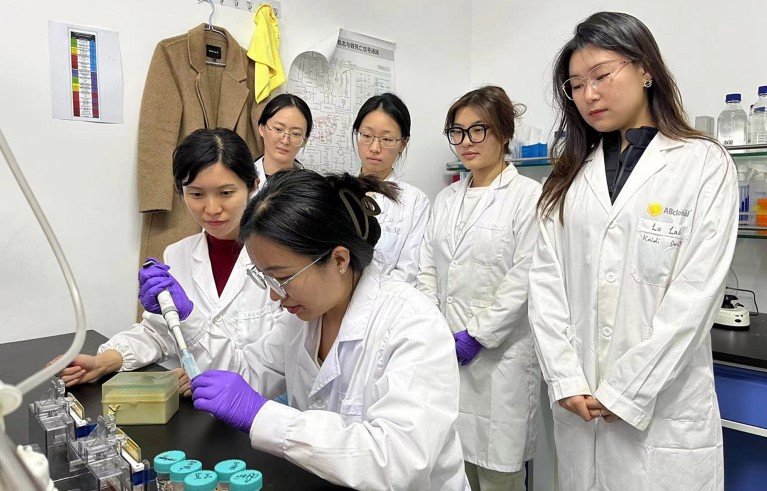
Early-careers researchers in China need highly sought-after grants to progress in their career.Credit: Xinhua/Shutterstock
Scientists in many countries face intense competition for research funding, but the situation in China is particularly fierce, say researchers, especially for those in their early-career. To address this, one of the country’s largest funders of basic research, the National Natural Science Foundation of China (NSFC), has introduced reforms over the past year aimed at better supporting young scientists. But some worry that the changes are making matters worse.
The NSFC, based in Beijing, oversees several programmes that provide funding through competitive grants. This year, there was a massive jump in applications, more than 380,000 overall, up 26% compared with last year. Only 13% of those were successful, compared with 16% in 2023.
The success rate for the NSFC’s Youth Scientists Fund, which supports male researchers who are under 35 and female researchers under 40, also declined, from 17% in 2023 to 15.5% this year, according to an analysis posted on WeChat. The number of applications to the fund grew by 11.3% over the same period, according to a report compiled by the NSFC.
“The competition is very, very intense,” says Cong Cao, a science-policy researcher at the University of Nottingham Ningbo China. For comparison, the US National Science Foundation’s funding rate was 29% in 2023.
New policies
Researchers say the jump in NSFC applications this year stems from the foundation’s decision to eliminate its requirement that applicants who were unsuccessful for two consecutive years wait a year before reapplying.
Another recent policy change is an extension to the Distinguished Young Scholars (DYS) programme, which gives outstanding young scientists an opportunity to pursue research of their choosing, funded for five years. From this year, up to 20% of these scholars will be eligible for a further five years of funding.
“It’s a positive development,” says Albert Hu, an economist who focuses on science and technology at the China Europe International Business School in Shanghai. It suggests that China’s policymakers are becoming more aware that basic research projects need long-term support, Hu says.
But others are concerned that providing extra funds to a small number of already well-supported DYS researchers will make it more difficult for other early-career researchers to obtain limited grants. Typically, DYS researchers already have access to a wide range of funding sources from universities, local governments and the corporate sector, says Yanbo Wang, a science-policy researcher at Hong Kong University. He’s also not convinced that the funding boost will result in better research. “There is little evidence to suggest that these few individuals can utilize the additional funding more effectively than those who have been overlooked for funding,” says Wang.
The NSFC declined Nature’s request for comment about the impact of the policy changes. In August, the head of the agency, Dou Xiankang, told Nature that the reforms were designed to provide further support for young scientists. As part of them, the NSFC also introduced funding for undergraduate and PhD students to help them start their research careers.
Old problem, getting worse
The struggle to secure funding isn’t unique to researchers in China, says Li Tang, a science-policy researcher at Fudan University in Shanghai. “Many countries face similar challenges in balancing the demand for excellence in research with equitable funding distribution,” says Tang.
But China’s broader research-evaluation system — which places emphasis on researchers securing NSFC grants, in particular — is making the competition for limited funding particularly intense, says Tang.
NSFC grants are a measure of achievement when researchers are assessed for contracts, promotions and tenure, says a researcher who requested to remain anonymous because they are worried their view might harm their chances of obtaining NSFC grants in future. Many early-career researchers view NSFC funding as opening the door to career opportunities rather than just as a vehicle to fund their projects, the researcher says. “We regard the NSFC as a bridge.”
Bigger research pool
The growing number of early-career researchers is set to add to funding pressures. In 2023, around 1.3 million graduate students were enrolled in universities across China, an increase of 4.8% on the previous year, according to the Ministry of Education.
Another factor adding to the pressure to obtain grant funding is that many universities don’t offer start-up packages to young scientists, which forces them to obtain grants from elsewhere to get up and running, adds Cao. “If you don’t have money from external sources, it’s very difficult to start your career,” he says.
One way to ease the competition and pressure on young Chinese scientists is to create a more diverse range of funding sources, says Hu. Universities and research institutions should also base their research evaluations on the outcomes of funded projects instead of the number of grants researchers win, he adds. “There has to be a change in the way these young scientists are evaluated,” says Hu.
